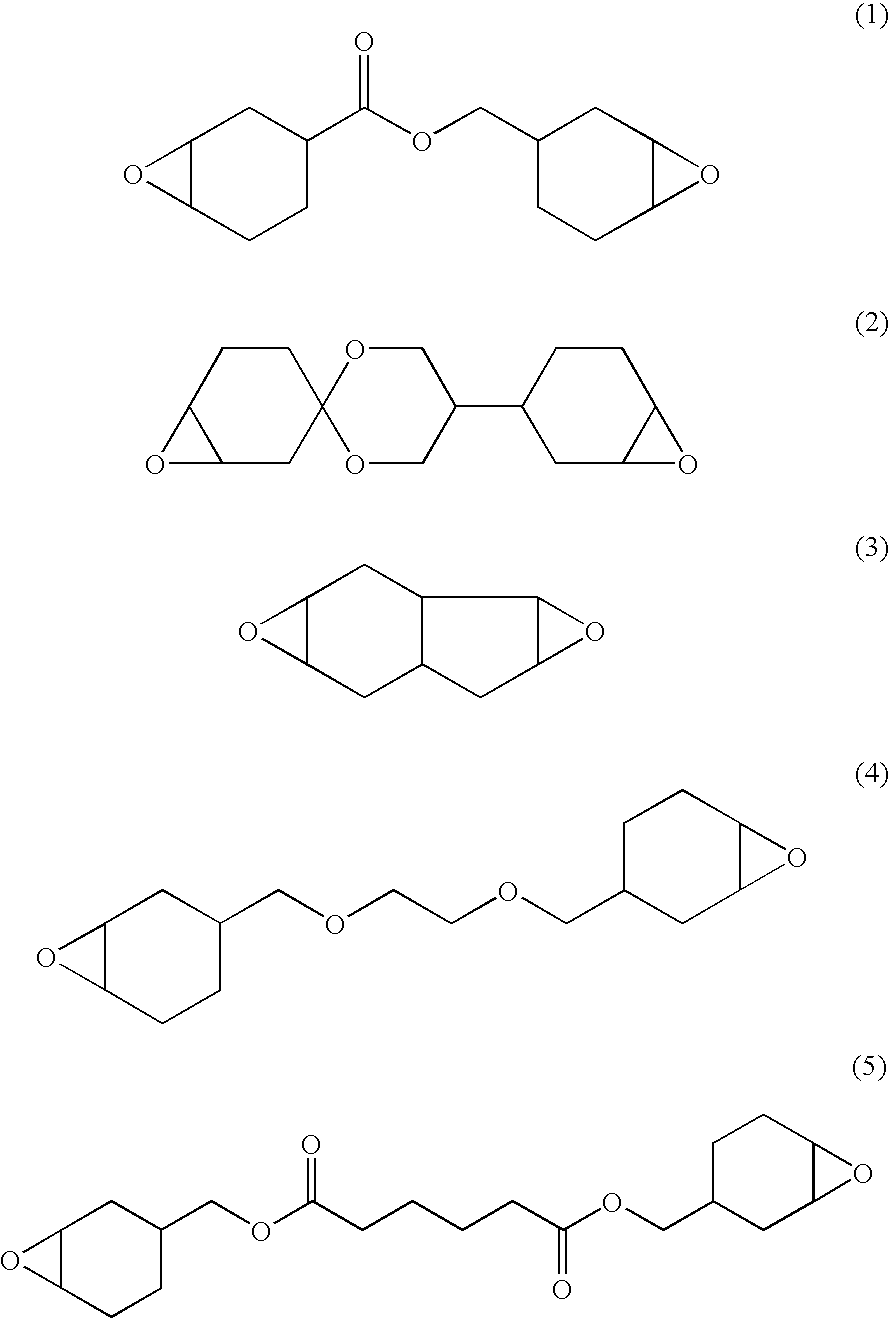Cationically Curable Epoxy Resin Composition
- Summary
- Abstract
- Description
- Claims
- Application Information
AI Technical Summary
Benefits of technology
Problems solved by technology
Method used
Image
Examples
example
(1) Materials
[0059] The following materials were used in Examples and Comparative Examples.
[0060] Epoxy resin 1: a bisphenol-A type epoxy resin, RE-310S (Nippon Kayaku Co., Ltd.), which is a liquid at 25° C. with a viscosity of 13000 to 17000 mPa·s and an epoxy equivalent of 175 to 190 g / eq;
[0061] Epoxy resin 2: an alicyclic epoxy resin, bis(3,4-epoxycyclohexyl) adipate (Union Carbide Inc.; UVR-6128);
[0062] Epoxy resin 3: an alicyclic epoxy resin, UCB Chemical Corporation CAT002;
[0063] Epoxy resin 4: a hydrogenated bisphenol-A epoxy resin, EPI CLON EXA-7015 (Dainippon Ink And Chemicals, Incorporated) having an epoxy equivalent of 210 g / eq;
[0064] Epoxy resin 4: a dicyclopentadiene type epoxy resin, XD-1000 (Nippon Kayaku Co., Ltd.), having an epoxy equivalent of 240 to 260 g / eq;
[0065] Silane coupling agent: γ-glycidoxypropyltrimethoxysilan;
[0066] Polyol: polyether polyol, Sumiphen (TM of SUMITOMO BAY ER URETIIANE CO., LTD);
[0067] Silica: specific gravity 2.635, average parti...
examples 1
(2) Examples 1, Comparative Examples 1 to 4
[0071] The ingredients shown in Table 1 were blended to prepare a resin composition. On a glass plate was applied each resin composition to a thickness of 1 mm and the product was irradiated with light from its surface. A light source used was a medium pressure mercury lamp (Eyegraphics Co., HO15-L312), which was adjusted such that a light intensity at 365 nm was to be 150 mW / cm2 as determined at 365 nm with a UV meter (Ushio UIT101). The irradiation time was 30 seconds. The total irradiation energy was 3600 mJ / cm2. Thereafter post-curing was performed at 120° C. (degrees centigrade) for 1 hour. Cross hatch tape test (10×10 cuts) according to ASTM D3359 were conducted to thus-obtained samples for the evaluation of water resistance. The results were depicted in Table 1.
TABLE 1ExampleComparative Example11234Composition (wt %)Epoxy resin 169.569.574.076.986.0(Aromatic type)Epoxy resin 2———10.0—(Alicyclic type)Epoxy resin 3——1.5——(Alicyclic t...
examples 2 to 4
(3) Examples 2 to 4
[0074] The epoxy resins were changed and the ingredients shown in Table 3 were blended to prepare a resin composition. The curing condition is the same as that used in Table 1 except that UV light was irradiated at light intensity of 150 mW / cm2 for the period until tack on the surface of the resin composition disappeared, which was shown in Table 3 as the energy required for the curing. The smaller energy means faster curing. The water resistance were evaluated by Cross hatch tape test as Example 1. The results were depicted in Table 3 with the result of Example 1. Thus, the use of alicyclic epoxy resins selected from the group consisting of hydrogenated bisphenol type epoxy resins and dicyclopentadiene type epoxy resins increases the curing rate of the composition while not deteriorating the adhesiveness.
TABLE 3Example2341Composition (wt %)Epoxy resin 1—34.5—69.5(Aromatic type)Epoxy resin 465.534.038.5—(rapid curabletype)Epoxy resin 5——30.0—(rapid curabletype)S...
PUM
| Property | Measurement | Unit |
|---|---|---|
| Percent by mass | aaaaa | aaaaa |
| Percent by mass | aaaaa | aaaaa |
| Percent by mass | aaaaa | aaaaa |
Abstract
Description
Claims
Application Information
 Login to view more
Login to view more - R&D Engineer
- R&D Manager
- IP Professional
- Industry Leading Data Capabilities
- Powerful AI technology
- Patent DNA Extraction
Browse by: Latest US Patents, China's latest patents, Technical Efficacy Thesaurus, Application Domain, Technology Topic.
© 2024 PatSnap. All rights reserved.Legal|Privacy policy|Modern Slavery Act Transparency Statement|Sitemap



